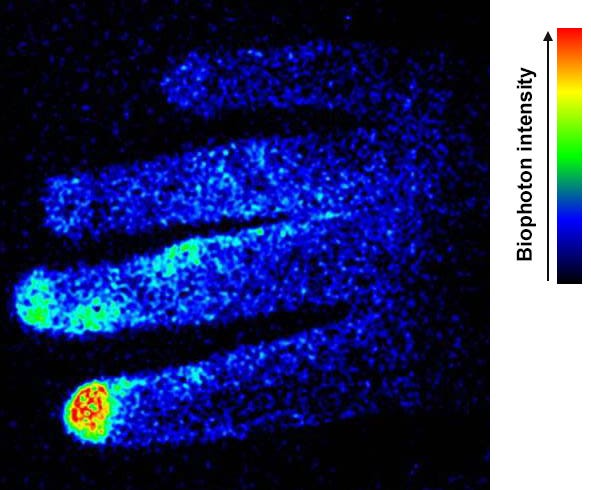6th Sense: Are We Communicating Using Invisible Light? Biophotons and DNA — Part 2
In our first post we talked about inter-organism communication by the mean of light. This could be another function of the non-coding part of the DNA.

The question whether we can link biophoton emission to some biochemical functions of the genome, in particular outside of the well-studied protein-coding regions, is a very challenging one. This is equivalent to considering the DNA and the genome as active biological lasers that emit an electromagnetic field in coherent quantum state when the organism is healthy. The emission is less coherent in case of diseases or malfunction. In order to study the question, we postulate the following hypothesis.
Hypothesis 1: A transfer function exists between the structure and mechanisms of the DNA and biophoton emission.
Such a transfer function would mathematically describe the relationship between resonance features of the DNA strands and signal characteristics of the observed biophoton emission. Empirically speaking, a model of the DNA should be developed, that exhibits geometrical features, electromagnetic wave generation and propagation as well as sequence information of nucleotides. (Blank & Goodman, 2011) provided evidences that the DNA is a fractal antenna. The biophoton signal should be modeled as a biological signal that exhibits describing properties such as wavelength, frequency, spectrum, statistical distribution of components and coherence. The hypothesis postulates that the mechanism of emission can be modeled as a transfer function between the DNA system and the biophoton observation, meaning that given a known set of parameters values related to the DNA, one can predict the characteristics of the biophoton emission with significant minimal error.
The hypothesis is testable by the mean of parameters identification tools borrowed from the control system theory. Given the genome of a subject and a record of his biophoton emission, one can fit the mathematical model (transfer function) to geometric, electromagnetic and wave features of the genome on one side, and to the wavelength, frequency, spectrum, and statistical distribution of components and coherence of the biophoton signal on the other side. Model fitting with experimental data is an optimization task during which the difference or error between the experimental data and the model simulation is minimized as much as possible. If a set of unique parameters is found, then the hypothesis is accepted.

The hypothesis is also falsifiable by experimentally showing that the DNA is not the major source of biophoton emission. If another source is found in the cell, which can strongly interfere with DNA emission of biophotons, than it will be obvious that the measured biophoton signal is a product of emissions coming from different senders. The refutability of the hypothesis can be proved by measuring biophoton emission on subjects where we know for sure that candidates for secondary sources of biophoton are present in great number. An example could be a subject with a high concentration of free radicals in the cell because it was suggested that biophoton emission increases with increasing free radical production. If we find that the parameters identification task produces acceptable results when fitting experimental data from the subject with free radicals with our model, then the hypothesis is rejected.
Hypothesis 2: human can be unconsciously affected by biophoton emission sent from another organism.
Mainstream science acknowledges inter-organism communication based on sensory physiology: somatic sensing, olfaction, taste, hearing, equilibrium and vision. The background provided in our previous post opened several questions regarding alternative forms of communication between individual of the same species and between individuals of different species. Living organisms may be exchanging information through biophotonic communication.
According to the communication theory, the basic elements needed would be a source, a sender, a channel, a receiver, a destination and a message. Rather than defining each element and speculating what it can be as done in (Grass, Klima, & Kasper, 2004), we postulate a hypothesis that is related solely to the receiver, as a human being. One reason is that optical electromagnetic waves emitted by the mean of biophotons are very weak signals with minimal frequency. As consequence, we may lack the technology to detect the full signal strength and frequency, despite the advances in photomultiplier techniques and high sensitive cameras. We might not being capable of technically measuring the whole message, although we know that there is a message, as research data have clearly shown. Of course it is also possible that our equipment are already detecting the signal in its whole strength and the observed low resolution is enough for leaving organisms to communicate, because they do it quickly and efficiently so the signals are short and simple, like a binary code.

Our hypothesis considers a particular case of inter-organism communication and postulates that human can receive biophotons that were sent by another organism and even react to them. The more the emission is coherent from the sender and receiver perspective, the clearer the information is transmitted. If it is true that human does not only receive and store biophotonic information at the molecular level, but also processes it, then a response should be observed at the organ level, and higher at the level of unconsciousness. Therefore the hypothesis is verifiable by the mean of modern medicine. As the hypothesis suggests an unconscious response, an experiment can measure the activity of the autonomic nervous system of a human receiver at the close vicinity of a biophotons sender. The vagal and sympathetetic nervous activity can be indirectly and noninvasively measured from common biological signals such as electroencephalogram, heart rate variability, galvanic skin response and even functional magnetic resonance imaging. The condition of coherent emission of the sender can be realized by selecting healthy organisms from different species that have passed a coherence test, i.e. their biophoton emission has a great degree of coherence. Examples can be human subjects who intensively practice meditation and healthy plants.

The hypothesis is also falsifiable by showing that all human, regardless of the coherency of their own biophotons emission, will react unconsciously as soon as they come to the vicinity of a biophotonic field sent by coherent or non-coherent sender. The hypothesis will also be rejected if a case is found where a coherent sender could not affect a coherent human receiver after several trials.
to be continued …
